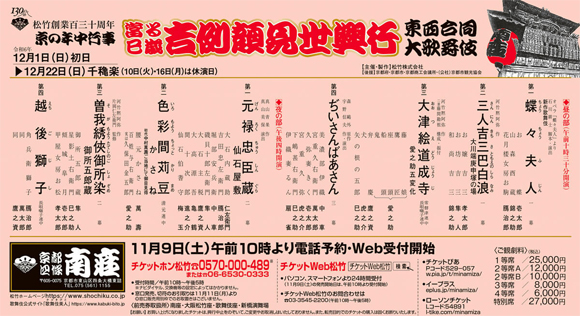| Comments |
The traditional kaomise in Ky˘to at the Minamiza.
Due to an injury, Kataoka Ainosuke can't perform this month.
Ch˘ch˘ Fujin:
(Madame Butterfly)
Och˘ (Nakamura Kazutar˘) is waiting for her American husband Pinkerton to return after he went back to his home country,
but she hears no news of him for three years. The businessman Yamamori Toriz˘ (Nakamura Kinnosuke) makes advances to her, asking her to be his legal wife,
but she turns him down. As Toriz˘ tries to take her back home by force, Okoma (Nakamura Ganjir˘) of the Kagetsur˘ mediates between them bringing
a letter from Pinkerton, which says that he took a new wife in his home country and wants to take care of his child whom Och˘ bore him.
Though Okoma understands Och˘'s feelings, Okoma warns her that her son will suffer hardship if he stays in Japan.
After worrying what she should do, she finally accepts Okoma's advice. A new kabuki production adapted from a familiar opera.
Sannin Kichisa:
(Three Thieves Named Kichisa)
The playwright Kawatake Mokuami excelled at portrayals of thieves and this short scene,
with its music and poetic lines, is one of his most famous.
A beautiful young woman helps out a woman who is lost on the road.
But she is actually Oj˘ Kichisa, a male thief who is disguised as a woman.
He steals an immense sum of money that the woman is carrying and this leads to
an encounter on this riverbank of three thieves, all with the name Kichisa.
The two others Kichisa are Osh˘ Kichisa, a bonze turned thief, and Ob˘ Kichisa, an ex-samurai turned thief
Though they start out as rivals, they decide to become blood brothers
and form a gang. Featuring Kataoka Takatar˘ as Oj˘ Kichisa, Nakamura Kinnosuke as Osh˘ Kichisa and Nakamura Hayato as Ob˘ Kichisa.
ďtsue D˘j˘ji: "Musume D˘j˘ji" or "The Maiden at D˘j˘ji Temple"
is the most famous dance to display the alluring charm of an onnagata female
role specialist and has inspired many variations. It shows the ghost of a woman who was
transformed into a serpent out of passion and destroyed a temple bell. In this particular version,
a mysterious figure appears as various characters famous from the cartoon like pictures called ˘tsue
before revealing that this is the woman of the "D˘j˘ji" story.
Featuring Kataoka Ainosuke Nakamura Kazutar˘ in the 5 roles of this hengemono and Band˘ Minosuke in the role of the Demon Queller.
Jiisan Baasan: based on a short story by Mori ďgai, this modern play
by Uno Nobuo shows a loving young couple. The samurai Iori travels to Ky˘to with
his lord, leaving Run, his beloved wife, behind. While there, he attacks another
man in a fight over a sword and is forced into house arrest, separating him from
his wife. Many years later, he returns to his home as an old man.
There he meets an elderly woman and they do not recognize each other
until she sees the one thing that has not changed with age,
Iori's peculiar habit of putting his hand to his nose.
Starring Ichikawa Chűsha and Nakamura Senjaku as Iori and Run.
Sengoku Yashiki:
(At the Mansion of Lord Sengoku)
"Kanadehon Chűshingura", also known as "the Treasury of the 47 Loyal Retainers",
is one of the most popular plays in Kabuki and is based on a true incident that took place in the Genroku period.
Between 1934 and 1941, the modern playwright Mayama Seika painstakingly reworked this theme into the 20th
century masterpiece, "Genroku Chűshingura", a vast cycle of ten plays focusing on a more historically accurate
telling of this revenge classic with different incidents and different characters. The particular play being presented this
month shows the retainers after they have succeeded in avenging their lord's death and now await their judgment.
Lord Sengoku (Living National Treasure Nakamura Baigyoku) is an official of the shogunate, but he is anxious to discuss the philosophy and justification for the attack
with the leader of the retainers, Kuranosuke (Living National Treasure Kataoka Nizaemon), before the men are sent to various lordsĺ mansions to be kept in custody until
the shogunate decides how they will be punished.
Featuring also Nakamura Ganjir˘ & Ichikawa Chűsha.
Kasane: one can never escape past evils. Yoemon is fleeing to the
countryside, but Kasane, the woman he abandoned, refuses to let him go.
She catches up with him at a lonely river bank. A skull stabbed with a
scythe appears and Kasane is possessed by its spirit, actually
the spirit of her dead father, and her face suddenly becomes disfigured.
She pours out her feelings of jealousy and resentment and Yoemon kills Kasane,
but even after her death, he cannot escape her vengeful spirit.
Starring Nakamura Manju as Kasane and Kataoka Ainosuke Nakamura Mantar˘ as Yoemon.
Gosho no Goroz˘: a portrait of the Yoshiwara
pleasure quarters at the height of its splendor. Rival gangs dressed
in the height of fashion exchange stately speeches before fighting
in the elaborate poetic cadences of Kawatake Mokuami, the last great playwright of Kabuki.
Goroz˘ is the handsome leader of a gang, but his lover, the top courtesan
Satsuki pretends to reject him to save his life. Tragedy strikes when Goroz˘
is driven to revenge. Starring Nakamura Hayato as Goroz˘, Band˘ Minosuke as his rival in love,
Nakamura Kazutar˘ as Goroz˘'s lover, the courtesan Satsuki and Kamimura Kichitar˘ as ďshű,
a courtesan who is tragically killed.
Echigo Jishi: one of the most popular dances in the Kabuki repertory, this shows traveling
entertainers (Nakamura Ganjir˘, Nakamura Mantar˘, Nakamura Takanosuke) that performed lion dances, with an adult playing the music and a child doing acrobatics like
a little lion. The dance shows the feelings of the adult performer and his feelings for his home in the
Echigo region and finally ends with the famous white cloth of
the area as he waves long strips of cloth in a variety of different patterns.
Sources: Earphone Guide Website or Sh˘chiku Kabuki Official Website
|









